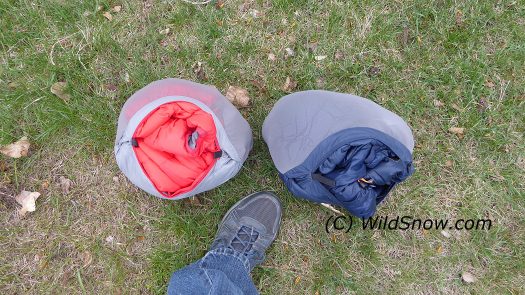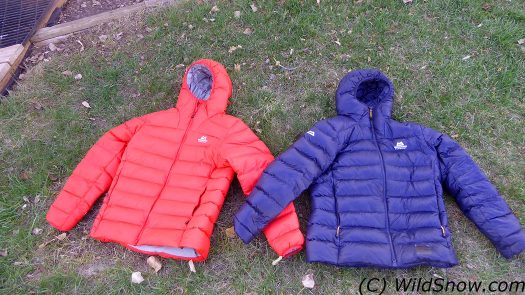Nearly every winter, I try one or two new puffy jackets. These down-filled warmth layers form an integral part of my kit. They’re what I wear on cold summits — or at chilly trailheads before I stim my metabolism with the climbing. They’re also my street wear for chilly European mid-winter wanders — or when we sometimes find ourselves in Canadian latitudes.
The trend lately has been thinner puffs with the “horizontal rib” “caterpillar” look created by constructing narrower down tubes. I don’t know who began that — it is ridiculous — resulting in thinner and colder jackets simply because the narrow tubes can not loft as thick as wider tubes, as well as every additional sewn-through seam being a cold spot. In all my testing over the years of sewn-through down jackets I never experienced the need for more tubes. Clothing companies will I hope move away from this, back to to wider tubes and fewer seams, or perhaps they’ll even figure out a way to build baffled (not sewn-through) jackets that are not too pricy.
(Some of the “caterpillar” jackets out there have even more tubes than these do! The extreme versions are clearly an impractical fashion piece, as a thick fleece would be just as warm, probably one third the price, and ten times more moisture resilient.)
Rant over. Dewline and Skyline are colder than previous Mountain Equipment puffies I’ve owned, but they still worked if I made sure to carry a robust mid-layer. Good enough for a review — though next season I’ll probably add a few grams and again carry a warmer puffy.
Skyline and Dewline are virtually the same design. Difference: Skyline is shelled with water resistant fabric and does not use water resistant down, while Dewline does _not_ have a water resistant shell but instead uses water-resistant down (my preference). Both jackets use what they call 700 fill down, though in my opinion the WR down lofts slightly less. The Skyline is definitely warmer — if dry and allowed to loft. But after wadding either jacket into my backpack after a dusting of snow, they were virtually identical in warmth. More, at times the Dewline was clearly at an advantage due to moisture retention.
Indeed, I remain unconvinced that down can be made any more reliable by covering it with various water resistant or waterproof-breathable fabrics. Down is incredibly sensitive to moisture. The only real solution is either WR down, or synthetic. Either used with lightweight shell fabric, that’s the magic formula in my opinion.
Both jackets are cut at what I consider to be the perfect length, well over the belt in the front and dropping a bit lower than that at the rear. The hoods will fit over a helmet, but I’d not call them “helmet compatible.” Best feature is the commodious inside breast pocket that’s large enough to easily stuff the jacket in.
Back to basics, these are indeed lightweight puff jackets. They’re simple, which I like. No wrist Velcro catching on stuff, no fancy hood trim, basic hem drawstring, three pockets. Skyline total weight 460 grams — Dewline total weight 442 grams.

Both jackets stow in their interior vest pockets. For us this is nearly a mandatory feature. Good to see.
Conclusion: Nice looking puffies at a good price. They’re well well made. AS with all “caterpillar” look jackets boasting smaller down tubes, they’re not particularly warm. Thus, as activewear or springtime insulation the Skyline and Dewline are fine, but if you you’re needing a “real” puff jacket for summit lounging or chilly lunch stops, look at other Mountain Equipment jackets (see below).
Or shop for the Mountain Equipment Vega, an offering with wider tubes, more fill, and more loft. Total weight 621 grams. This is closer to our ideal puff jacket, but I’d prefer it in the same super-lightweight “Helium” fabric used for the Dewline and Skyline.
WildSnow.com publisher emeritus and founder Lou (Louis Dawson) has a 50+ years career in climbing, backcountry skiing and ski mountaineering. He was the first person in history to ski down all 54 Colorado 14,000-foot peaks, has authored numerous books about about backcountry skiing, and has skied from the summit of Denali in Alaska, North America’s highest mountain.


